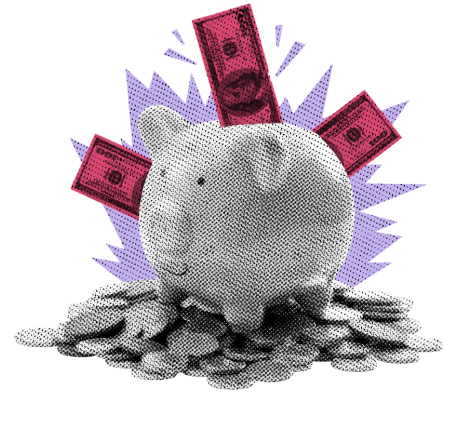
Stocks had a mixed close yesterday in a rocky start to the week as investors grew dubious over the path of Fed rate cuts. A closely followed, private economic health indicator declined more than expected with manufacturing orders and interest rates to blame.
Are those hawks circling above? Is inflation still a problem? Nobody seems to be talking about inflation anymore. Sure, prices are abnormally high compared to where they were just a few years ago, but they appear to be rising more slowly than they were, which is a good thing. That is, in plain English, the definition of disinflation. It is the opposite of rising inflation, which is what the Fed so avidly pursued in its draconian rate hiking campaign in 2022 and 2023. Inflation is easing and the Fed decided to focus on the other side of its dual mandate, employment. Unemployment has been creeping up which gave the Fed a solid exit ramp from its hawking, allowing it to shift to… er, dove’ing (is that even a word). Anyway, the Fed decided to pivot with a bang, handing out an extra-large -50 basis-point rate cut last month. That should be positive for the economy and ultimately stocks and bonds, but unfortunately, as we have learned it is not that simple.
Since the Fed decided to start cutting its key lending rate, Treasury note yields have climbed. Go ahead… read that last sentence again. How is that possible, you wonder? 2-year Treasury Note yields, which are heavily influenced by monetary policy, have risen by around ½ percentage point since the Fed cut last month. Why? Well, while the 2-year is definitely influenced by the Fed, it still attempts to reflect where overnight rates might be in 2 years. So, rising yields in the 2-year yield reflect investors’ expectations for future Fed cuts to be slower than they were a month ago. Those expectations are changing because of a series of positive economic numbers that suggest that the economy may be healthier than the Fed thought it was back in September. It should, therefore, be in no rush to deliver aggressive cuts. As a result, the 2-year simply adjusted. You can see that change in expectations even more dramatically if you look at Fed Funds futures which shifted from expecting 4 to 5 rate cuts before yearend to 1 to 2, with only a 62% chance of 2.
So, what does that really mean to you and me? Well, while the 2-year Note’s yield does play a role in determining short-term borrowing costs, it is really SOFR (Secured Overnight Financing Rate) that affects loans like Adjustable-Rate Mortgages (ARMs), SBA loans, short-term corporate borrowing, construction loans, home equity lines of credit (HELOCs), credit card rates, and personal loans; SOFR has not risen since the September cut, but rather has been closely tied to Fed Funds. Therefore, the change in 2-year yields really only gives us some color on investors’, short-term sentiment. The decline in SOFR with Fed Funds does have the Fed’s desired effect of making those loans mentioned above more attractive, which is stimulative… or rather less restrictive.
But what about those other loans used to buy high ticket items, like homes, cars, and education (chuckling)? When the Fed cut rates last month, I can’t tell you the amount of interview questions I received about its impact on mortgage rates and the housing market, because I lost count. Everyone was convinced that homebuyers would suddenly get instant relief with lower mortgage rates which would quickly ease up the tight real estate market and allow home price inflation to slow down. Nope, that didn’t happen. In fact, 30-year fixed mortgage rates have gone up by around ½ percentage point since the Fed cut. Why? Because mortgage rates, along with auto loans and student loans, are tied to 10-year yields, which gained some +55 basis points since September’s rate cut! So, in essence, what has happened is the opposite of the Fed’s desired effect. While it was attempting to ease credit conditions, mortgages actually became MORE restrictive. Check out the 10-year yield chart that follows and then keep reading to find out why those yields have risen.

On this chart, you can see how 10-year yields have clearly climbed since the Fed cut short-term rates last month. Though this seems counterintuitive, there is a good explanation. Remember that bond yields are in the hands of traders. Just like with stock prices, Treasury prices and their subsequent yields are based on investors’ expectations for the future. If investors expect inflation to be higher in the future, they will demand higher yields to compensate for that inflation. Recently hot economic numbers may lead investors to believe that the economy will soon run hot once again, spurring a reemergence of inflation. There is also something known as term premium, which, in theory should afford investors additional yield for longer maturities; a kind of compensation for taking risk over a longer period of time. In other words, more can go wrong the longer you are locked in for. As we enter a period of economic uncertainty, that term premium should increase.
Yes, I did say “a period of economic uncertainty.” We are exactly two weeks away from an election with the two candidates neck and neck in the race for the White House, and their respective ideologies on governing are… um, vastly different. It is, therefore, fair to say that at this moment, there is no way to know with any real certainty what the economy is going to be like in a year from now, certainly not 10-years from now. Well, now that that cat is out of the bag, let’s address it. While both candidates clearly have different policy agendas, they both seem to agree on at least one tactic: spending more than they have, AKA deficit spending. Each has proposed increased spend and both have explanations on how they intend to pay for those increases. In reality, and we have history as our guide, the spending will more likely not be paid for and the overall deficit will increase. How will those expenditures be paid for? Of course, through increased borrowing. The Government borrows money by selling bonds… Treasury Notes and the like. Basic economics alert: increased supply means lower prices! Lower prices in bonds mean higher yields. To understand the magnitude of this challenge, check out the following chart then follow me to the finish.

That’s right, just check out that growth trajectory of outstanding Treasury debt. Never mind the actual number, just check out the slope of the growth. You can go out and Google all the various analyses of how much each candidates’ plans will cost the US in deficit gains and you will be left with one thing. Both candidates are likely to increase the deficit and subsequently increase the debt burden of the US.
Now, there are plenty other explanations of why 10-year Treasury yields have gone up while the Fed is trying to cause rates to go down, but this one here, is a big one. Forget about the great potential which may come from all that proposed spending or whether that spending is worth it. Assume that’s all good, but don’t forget that there is a cost, and that it is us, you and me, who will bear it. While the dovish Fed is pulling its foot off the brake, hawkish bond traders are pressing down on it. Finally, it should be noted that the Fed could impact long-term Treasury yields if they wanted to through quantitative easing, but alas, the Fed is not easing, but rather it is still tightening by shrinking the balance sheet, just at a slightly slower pace than a few years back in its tightening cycle. Sorry folks, there are still hawks winging about.
YESTERDAY’S MARKETS

NEXT UP
- Philadelphia Fed Manufacturing Index (Oct) may have improved to -17 from -21.
- Philadelphia Fed Chief Patrick Harker will speak today as well as a number of his ECB counterparts.
- Earnings: Danaher, GM, PultaGroup, 3M, RTX, and Philip Morris International all beat on EPS and Sales while A O Smith, GE, Verizon, Sherwin-Williams, and Lockheed Martin missed the mark. After the closing bell, we will hear from Baker Hughes, Enphase Energy, CoStar Group, Manhattan Associates, and Seagate Holdings.
.png)

